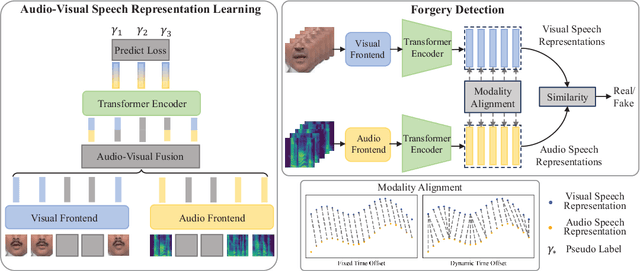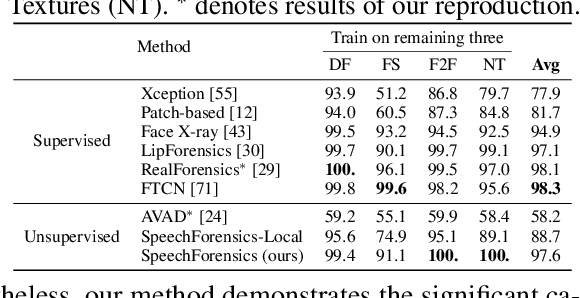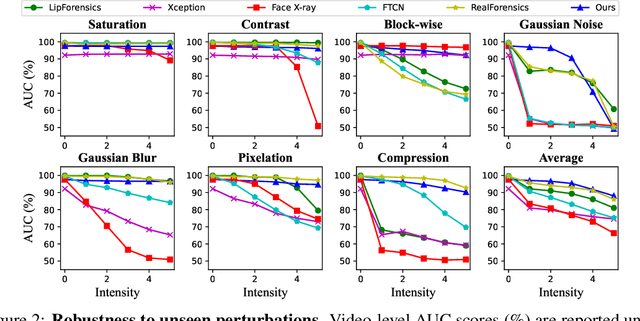Min Yu
SilverTorch: A Unified Model-based System to Democratize Large-Scale Recommendation on GPUs
Nov 18, 2025Abstract:Serving deep learning based recommendation models (DLRM) at scale is challenging. Existing systems rely on CPU-based ANN indexing and filtering services, suffering from non-negligible costs and forgoing joint optimization opportunities. Such inefficiency makes them difficult to support more complex model architectures, such as learned similarities and multi-task retrieval. In this paper, we propose SilverTorch, a model-based system for serving recommendation models on GPUs. SilverTorch unifies model serving by replacing standalone indexing and filtering services with layers of served models. We propose a Bloom index algorithm on GPUs for feature filtering and a tensor-native fused Int8 ANN kernel on GPUs for nearest neighbor search. We further co-design the ANN search index and filtering index to reduce GPU memory utilization and eliminate unnecessary computation. Benefit from SilverTorch's serving paradigm, we introduce a OverArch scoring layer and a Value Model to aggregate results across multi-tasks. These advancements improve the accuracy for retrieval and enable future studies for serving more complex models. For ranking, SilverTorch's design accelerates item embedding calculation by caching the pre-calculated embeddings inside the serving model. Our evaluation on the industry-scale datasets show that SilverTorch achieves up to 5.6x lower latency and 23.7x higher throughput compared to the state-of-the-art approaches. We also demonstrate that SilverTorch's solution is 13.35x more cost-efficient than CPU-based solution while improving accuracy via serving more complex models. SilverTorch serves over hundreds of models online across major products and recommends contents for billions of daily active users.
An Automatic Detection Method for Hematoma Features in Placental Abruption Ultrasound Images Based on Few-Shot Learning
Oct 24, 2025Abstract:Placental abruption is a severe complication during pregnancy, and its early accurate diagnosis is crucial for ensuring maternal and fetal safety. Traditional ultrasound diagnostic methods heavily rely on physician experience, leading to issues such as subjective bias and diagnostic inconsistencies. This paper proposes an improved model, EH-YOLOv11n (Enhanced Hemorrhage-YOLOv11n), based on small-sample learning, aiming to achieve automatic detection of hematoma features in placental ultrasound images. The model enhances performance through multidimensional optimization: it integrates wavelet convolution and coordinate convolution to strengthen frequency and spatial feature extraction; incorporates a cascaded group attention mechanism to suppress ultrasound artifacts and occlusion interference, thereby improving bounding box localization accuracy. Experimental results demonstrate a detection accuracy of 78%, representing a 2.5% improvement over YOLOv11n and a 13.7% increase over YOLOv8. The model exhibits significant superiority in precision-recall curves, confidence scores, and occlusion scenarios. Combining high accuracy with real-time processing, this model provides a reliable solution for computer-aided diagnosis of placental abruption, holding significant clinical application value.
SpeechForensics: Audio-Visual Speech Representation Learning for Face Forgery Detection
Aug 13, 2025



Abstract:Detection of face forgery videos remains a formidable challenge in the field of digital forensics, especially the generalization to unseen datasets and common perturbations. In this paper, we tackle this issue by leveraging the synergy between audio and visual speech elements, embarking on a novel approach through audio-visual speech representation learning. Our work is motivated by the finding that audio signals, enriched with speech content, can provide precise information effectively reflecting facial movements. To this end, we first learn precise audio-visual speech representations on real videos via a self-supervised masked prediction task, which encodes both local and global semantic information simultaneously. Then, the derived model is directly transferred to the forgery detection task. Extensive experiments demonstrate that our method outperforms the state-of-the-art methods in terms of cross-dataset generalization and robustness, without the participation of any fake video in model training. Code is available at https://github.com/Eleven4AI/SpeechForensics.
* Accepted by NeurIPS 2024
System-integrated intrinsic static-dynamic pressure sensing enabled by charge excitation and 3D gradient engineering for autonomous robotic interaction
May 30, 2025Abstract:High-resolution pressure sensing that distinguishes static and dynamic inputs is vital for intelligent robotics but remains challenging for self-powered sensors. We present a self-powered intrinsic static-dynamic pressure sensor (iSD Sensor) that integrates charge excitation with a 3D gradient-engineered structure, achieving enhanced voltage outputs-over 25X for static and 15X for dynamic modes. The sensor exhibits multi-region sensitivities (up to 34.7 V/kPa static, 48.4 V/kPa dynamic), a low detection limit of 6.13 Pa, and rapid response/recovery times (83/43 ms). This design enables nuanced tactile perception and supports dual-mode robotic control: proportional actuation via static signals and fast triggering via dynamic inputs. Integrated into a wireless closed-loop system, the iSD Sensor enables precise functions such as finger bending, object grasping, and sign language output.
GLIMMER: Incorporating Graph and Lexical Features in Unsupervised Multi-Document Summarization
Aug 19, 2024



Abstract:Pre-trained language models are increasingly being used in multi-document summarization tasks. However, these models need large-scale corpora for pre-training and are domain-dependent. Other non-neural unsupervised summarization approaches mostly rely on key sentence extraction, which can lead to information loss. To address these challenges, we propose a lightweight yet effective unsupervised approach called GLIMMER: a Graph and LexIcal features based unsupervised Multi-docuMEnt summaRization approach. It first constructs a sentence graph from the source documents, then automatically identifies semantic clusters by mining low-level features from raw texts, thereby improving intra-cluster correlation and the fluency of generated sentences. Finally, it summarizes clusters into natural sentences. Experiments conducted on Multi-News, Multi-XScience and DUC-2004 demonstrate that our approach outperforms existing unsupervised approaches. Furthermore, it surpasses state-of-the-art pre-trained multi-document summarization models (e.g. PEGASUS and PRIMERA) under zero-shot settings in terms of ROUGE scores. Additionally, human evaluations indicate that summaries generated by GLIMMER achieve high readability and informativeness scores. Our code is available at https://github.com/Oswald1997/GLIMMER.
How to Generate Popular Post Headlines on Social Media?
Sep 18, 2023Abstract:Posts, as important containers of user-generated-content pieces on social media, are of tremendous social influence and commercial value. As an integral components of a post, the headline has a decisive contribution to the post's popularity. However, current mainstream method for headline generation is still manually writing, which is unstable and requires extensive human effort. This drives us to explore a novel research question: Can we automate the generation of popular headlines on social media? We collect more than 1 million posts of 42,447 celebrities from public data of Xiaohongshu, which is a well-known social media platform in China. We then conduct careful observations on the headlines of these posts. Observation results demonstrate that trends and personal styles are widespread in headlines on social medias and have significant contribution to posts's popularity. Motivated by these insights, we present MEBART, which combines Multiple preference-Extractors with Bidirectional and Auto-Regressive Transformers (BART), capturing trends and personal styles to generate popular headlines on social medias. We perform extensive experiments on real-world datasets and achieve state-of-the-art performance compared with several advanced baselines. In addition, ablation and case studies demonstrate that MEBART advances in capturing trends and personal styles.
Using electrical impedance spectroscopy to identify equivalent circuit models of lubricated contacts with complex geometry: in-situ application to mini traction machine
Jul 07, 2023



Abstract:Electrical contact resistance or capacitance as measured between a lubricated contact has been used in tribometers, partially reflecting the lubrication condition. In contrast, the electrical impedance provides rich information of magnitude and phase, which can be interpreted using equivalent circuit models, enabling more comprehensive measurements, including the variation of lubricant film thickness and the asperity (metal to metal) contact area. An accurate circuit model of the lubricated contact is critical as needed for the electrical impedance analysis. However, existing circuit models are hand derived and suited to interfaces with simple geometry, such as parallel plates, concentric and eccentric cylinders. Circuit model identification of lubricated contacts with complex geometry is challenging. This work takes the ball-on-disc lubricated contact in a Mini Traction Machine (MTM) as an example, where screws on the ball, grooves on the disc, and contact close to the disc edge make the overall interface geometry complicated. The electrical impedance spectroscopy (EIS) is used to capture its frequency response, with a group of load, speed, and temperature varied and tested separately. The results enable an identification of equivalent circuit models by fitting parallel resistor-capacitor models, the dependence on the oil film thickness is further calibrated using a high-accuracy optical interferometry, which is operated under the same lubrication condition as in the MTM. Overall, the proposed method is applicable to general lubricated interfaces for the identification of equivalent circuit models, which in turn facilitates in-situ tribo-contacts with electric impedance measurement of oil film thickness. It does not need transparent materials as optical techniques do, or structural modifications for piezoelectric sensor mounting as ultrasound techniques do.
 Add to Chrome
Add to Chrome Add to Firefox
Add to Firefox Add to Edge
Add to Edge